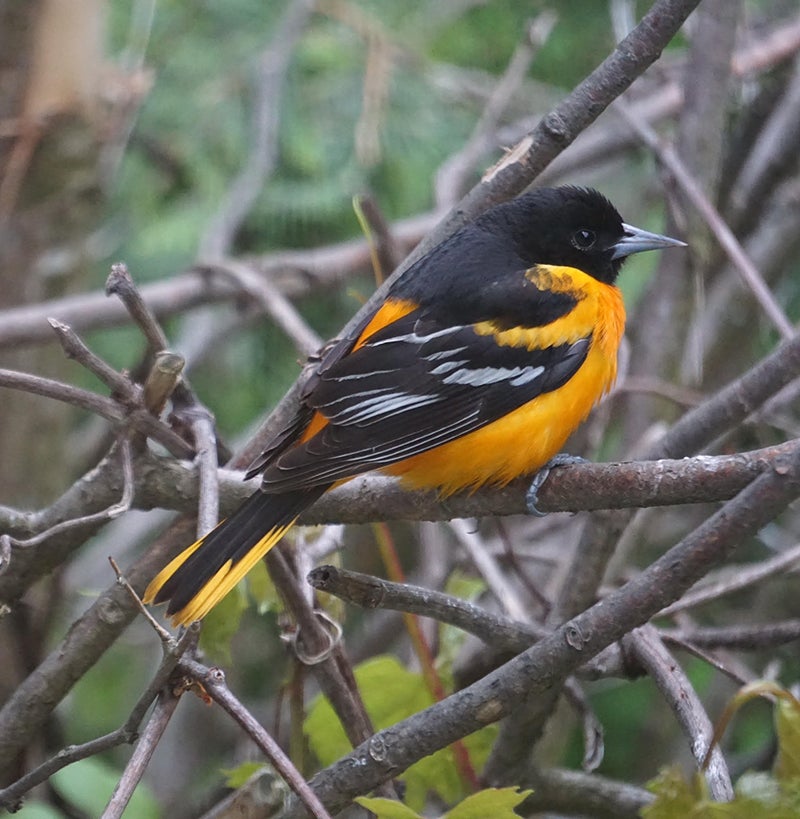Al Batt: Beetle art sells on eBay while Canada ignores national bird poll
Published 9:00 am Saturday, August 5, 2017

- A Baltimore oriole's diet consists of nectar, caterpillars, fruits, insects and spiders. Al Batt/Albert Lea Tribune
Al Batt of Hartland is a member of the Albert Lea Audubon Society. Email him at SnoEowl@aol.com.
My neighbor Crandall stops by.
“How are you doing?” I ask.
“Everything is nearly copacetic. I’m excited about our class reunion coming up. Still Bill was voted most likely to do nothing. He’s been successful at that. If he can’t reach it, he doesn’t need it. There is no excuse for laziness, but Still Bill keeps looking for one. He looks back on his life since we graduated and remembers with fondness the days that he got enough naps.”
Naturally
A vulture soared overhead on fingered wings. It hunted for carrion.
Canada geese flew over. Their molt leaves them flightless from mid-June into much of July. When they regain the ability to fly, the goslings are ready to fly with them.
I live in flyover land where nature entertains and educates. Naturally.
The Canada jay isn’t Canada’s jay yet.
The gray jay or Canada jay will not be the national bird of Canada after all. No bird will be. The Royal Canadian Geographical Society ran a two-year National Bird Project, inviting the public to vote for their favorites. The winner was the gray jay, a clever and curious inhabitant of all provinces and territories. The Society and its magazine, “Canadian Geographic,” had no official role in choosing a national symbol, but hoped the federal government would go along with the results. At this time, the Canadian government isn’t considering proposals to adopt a bird as a national symbol.
Q&A
“What are predators of monarch butterfly caterpillars and eggs?” Spiders and ants prey upon the eggs. Ants, spiders and wasps attack monarch larvae on milkweed plants. Parasitoids, specialized insects such as small flies and wasps, lay eggs on or inside caterpillars. Parasitoid larvae eat their prey from the inside out, emerging from the prey carcass as a pupa or adult. Parasites are smaller organisms that live and multiply inside the caterpillars, taking nutrients and resources.
“When do orioles leave here?” Baltimore orioles nest once per year. They could be done raising a family anytime from mid-June to mid-August. They move around freely after that. Some head south and some adults become secretive at the end of July when they begin their fall molt. Most of the orioles have left us by mid-September.
“How do I attract birds?” Park your car under a tree.
“How fast can an insect fly?” Fast. Rudy Scheibner, entomologist emeritus at the University of Kentucky in Lexington, found that a tabanid fly (such as a deer or horse fly) has been clocked at 90 miles per hour. I do not think the ones that chase me are quite that fast. Other fast-flying insects include hawk moths and sphinx moths timed at 33 mph, and dragonflies clocked at nearly 18 mph. Not all are speedy. The honey bee flaps her wings about 190 times per second, but flies at 7 mph.
“When do hawks nest here?” Red-tailed hawks nest from February to June. The female lays one to four eggs, which take 28 to 32 days to hatch. The young, which are raised by both parents, are covered with white down for the first week, until their feathers begin to grow. After six or seven weeks, the young hawks finally leave the nest. Cooper’s hawks nest from March to June. The incubation period is 30 to 36 days, with the nestling stage lasting another 27 to 34 days.
“How many eggs does a monarch butterfly lay and when do they finish laying eggs?” Monarchs usually lay a single egg on a plant, often on the bottom of a leaf near the top of the plant. It’s difficult to tell how many eggs a female lays during her life, but the average is probably from 100 to 300. The eggs hatch about four days after they are laid. The last eggs are generally laid in July and August. Some adults move south in late July and August. Caterpillars of the last brood typically appear by the middle of August. They pupate by the end of August. In September, adults of the year’s last generation of monarchs begin congregating in large numbers on the foliage of trees and shrubs. By the end of October, they have left the state in a mass migration to their winter grounds. Monarch butterflies arrive in Minnesota around mid-May each year to start the process once again.
Stag beetle art
Spike, a pet stag beetle who lives in Japan, has a natural talent for drawing. Holding a felt-tip marker between his strong jaws, the slow-moving stag beetle creates abstract art on his mini canvas with what has been described as “colorful crisp lines.” Spike’s doodles have gained a following and his artwork is selling on eBay.
Thanks for stopping by
“You know, everybody’s ignorant, just on different subjects.” — Will Rogers
“Most of us are experts at solving other people’s problems, but we generally solve them in terms of our own and the advice we give is seldom for other people but for ourselves.” — Nan Fairbrother
Do good.

